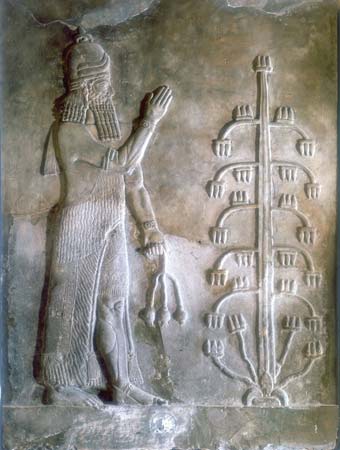|
Nimrod - The Screen Play by DanielS & Majorityrights  “The Mystery of Ishtar and Tammuz provides a key for understanding the world-redemptive destiny of the North Atlantic.” — K. H Nimrod - A Screenplay by Daniel Sienkiewicz and Majorityrights Associates Atmosphere music: King Crimson, The Sheltering Skye (studio version is appropriate, but only this live version is currently available on Youtube). Here, a recording of the studio version has been put on line. What is the antithetical taboo to miscegenation? Why of course it is incest. What is the greatest horror? It is unavoidable negative fate and its eternal recurrence. These themes are captured in the most classic, and primordial even, of Western narratives - in the story of Oedipus Rex and his mother/wife Jocasta, going back further historically, in the Egyptian story of Osiris and his half sister/wife Isis, back further still, to Ishtar and Tammuz, and finally to Nimrod, the first great man on earth, Genesis 10:10, and his mother/wife, Semiramis. Infiltration of the Babylonian Mystery Religion, Mother of all Wanton Harlots, 666, etc. Now the reason is understood as to why Abraham was against this mystery religion - because it sacralized re-breeding to the point of inbreeding even, where necessary, while Abraham in the case of Babylon wanted to promote out breeding among its gentiles and later, wanted to do that to Rome, in order to bring down these adversaries of Israel and the Jews. Hence the true evil mystery religions, universal Abrahamism, was imposed upon the world. Monotheistic of god’s “chosen people”, it was mongrelizing for all people except the Jews. And the antidote taboo-breaking of incest, its sacralization (as a ritualistic gesture), was confounded as the greatest evil - and indeed it must be mostly symbolic as such unions are obviously going to result in the likes of King Tut’s massive health problems (himself a product of incest) or even Charles and Harry’s odd taste in women, as sort of a convulsive, balancing reaction (a little levity there, for those who share my distaste for their taste). Thus, we want to avoid its reality beyond sacred ritual - and not just for physical maladies, but because we want to be careful about psychological effects as well on the formation of minds. At any rate, it is not commendable to take away the relatively agentive, mature and well informed choice of sexual partner. Sex is not only an important matter in determining the population of a human ecology, but a matter of confirmation and disconfirmation of personalities, virtues (or not), politics and more. “Enjoy the fantasy” may break the over alluringness of the incest taboo for those prone. So that’s some background to let the audience know that I’m not playing loosely with a justifiable taboo: if it is to be thematized as a counter taboo and aspect of sacralization toward a narrative to run counter to the Abrahamic cult of out-breeding, it must be done with sufficient accountability - even its narrative form must be discussed with caution and look toward matters of scientific verificaton; e.g., regarding what amount of inbreeding is alright, beneficial or detrimental; physically as well as psychologically and sociologically. Having issued that caveat…. I conceived of writing this screenplay many years ago (in the early 80s), still stuck in the Abrahamic way, I thought to render its story along the conventional Abrahamic lines, of the pervasive infiltration of the evil mystery religion - into Western traditions and “false” practices of Christianity, most symbolically with Christmas - to deceive the peoples of earth against the “true” Christianity.  The horror of eternal recurrence and discovery thereof: from Oedipus to Crohaven Farm, The Sentinel and The Omen. And salvation through the counter taboo from the horror of this unavoidable fate, eternal cycles and eternal recurrence. The horror of eternal recurrence and discovery thereof: from Oedipus to Crohaven Farm, The Sentinel and The Omen. And salvation through the counter taboo from the horror of this unavoidable fate, eternal cycles and eternal recurrence.Now I see it the other way around - that Abrahamism holds the true horror, is the evil mystery religion which has (more literally) infiltrated pervasive world practice.. e.g., we worship a virgin birth and self sacrifice instead of a product, to some extent, of tribal and royal line in-group breeding… symbolizing the cultivated turn, deliberation rather than sheer liberalism; i.e., not quite severe inbreeding, but recreating the genetic pattern of our human ecologies. With Abrahamism, rather, our fate is re-designated, or de-designated, as it were, “gentiles” - re-designated beyond our control, the fate of our people, beyond our management. Our hope is not our future with our peoples. Our only hope for salvation is through selflessness and altruism. The only foreseeable way out once having been intimidated by its book of Revelation, with eternal hell, 666, having to “hate one’s family”, where one is evil for even having a thought, etc., is to identify, to conceive of oneself, one’s people and to make oneself and people as-one-with the Jews as possible; for example:
That is the true culmination of the true infiltration of the evil mystery religion - i.e., Abrahamism, Abrahamic imperialism upon Western peoples and ultimately the whole world. It compels full culturalist merging as well, through false opposition, Noahide law and paleoconservatism of the Alt-Right. To be continued, that is, I will be cultivating this screenplay on line… The Counter Taboo… Opening scene: Music, The Sheltering Skye by King Crimson. Characters: mother, father with two children, a boy and a girl. The mother and father are decorating the Christmas tree with their son…he goes up stairs… Comments:3
Posted by Fleur de Nimrod on Thu, 22 Mar 2018 14:08 | #
Fleur de lis is the Babylonian Trinity, Nimrod, Semiramus and Tammuz
4
Posted by Ishtar Easter on Sun, 01 Apr 2018 09:37 | # “Ishtar”… was a day that commemorated the resurrection of one of their …their backs toward the temple of the LORD, and their faces toward the east, Easter is an ancient spring festival… The date of Easter is not fixed, but
Related Story at Majorityrights: Halloween: On The Eve of Ethnic Genetic Interest’s Most Important Day 6
Posted by Polish Inquisition on Mon, 01 Apr 2019 18:49 | # Catholic priests in northern Poland made a bonfire of books and innocuous objects they considered to be promoting “magic” and “idolatry”. https://www.bbc.co.uk/news/world-europe-47771706 So there’ll be no more transubstantiation then? Mass is cancelled, folks… Incidentally, Wagner’s Ring cycle is heavy on the old incest, isn’t it? 7
Posted by Semiramus on Mon, 01 Apr 2019 21:11 | # A young guy (film maker from England) was passing through town and I began cultivating the Nimrod screenplay with him. I exchanged a lot of material with him but lost it on an old computer and lost contact with him several years ago. He was/is a liberal and so perhaps a bit shy about me. After several years, just recently, he contacted me again, having moved to New Zealand (I don’t know if I should be suspicious), with a bit of our discussion about the screenplay that I had in mind…just one page.. DanielS: Opening Scene, Christmas eve, a family around the tree ...sheltering sky music One gift is a bit weird…. Brother finds himself irresistibly drawn upstairs to his sister’s room. There are successions of events which foreshadow his fate and doom to pass eternity in hell… 666 is on the back of his hand and he starts seeing this number everywhere…
8
Posted by King Arthur on Mon, 01 Apr 2019 21:38 | # Speaking of incest, according to legend, King Arthur sired his half sister.... Post a comment:
Next entry: A crisis in the custody suite – part five
|
|

Existential IssuesDNA NationsCategoriesContributorsEach author's name links to a list of all articles posted by the writer. LinksEndorsement not implied. Immigration
Islamist Threat
Anti-white Media Networks Audio/Video
Crime
Economics
Education General
Historical Re-Evaluation Controlled Opposition
Nationalist Political Parties
Science Europeans in Africa
Of Note MR Central & News— CENTRAL— An approaching moment of Russian clarity by Guessedworker on Sunday, 11 May 2025 12:34. (View) Piece by peace by Guessedworker on Wednesday, 19 March 2025 08:46. (View) Into the authoritarian future by Guessedworker on Friday, 21 February 2025 12:51. (View) — NEWS — If this is an inflection point by Guessedworker on Thursday, 03 April 2025 05:10. (View) Sikorski on point by Guessedworker on Friday, 28 March 2025 18:08. (View) Shame in the Oval Office by Guessedworker on Saturday, 01 March 2025 00:23. (View) |
Posted by A ScReen Play by DanielS & MR on Mon, 26 Feb 2018 06:55 | #
Rated AA for Autistic Audience.
I had reworked this post a few times in December 2017, and re-posted it on the 25th accidentally titled “A SCEEN Play by”...
The audience can take the position that I do not know how to spell the word “screen” or that it was a typo that had neither been called attention-to for the fact of spell check not operating in the titling column of articles nor called attention-to for correction by reading audience - it was left that way for over two months!
Perhaps the audience entered the letter R psychologically as I must have…..
No harm other than the URL became written as “Sceen Play” as well and so it had to be corrected…
I am in remiss in my haste for not having spell checked the title within the body of the text section before posting…
DanielS